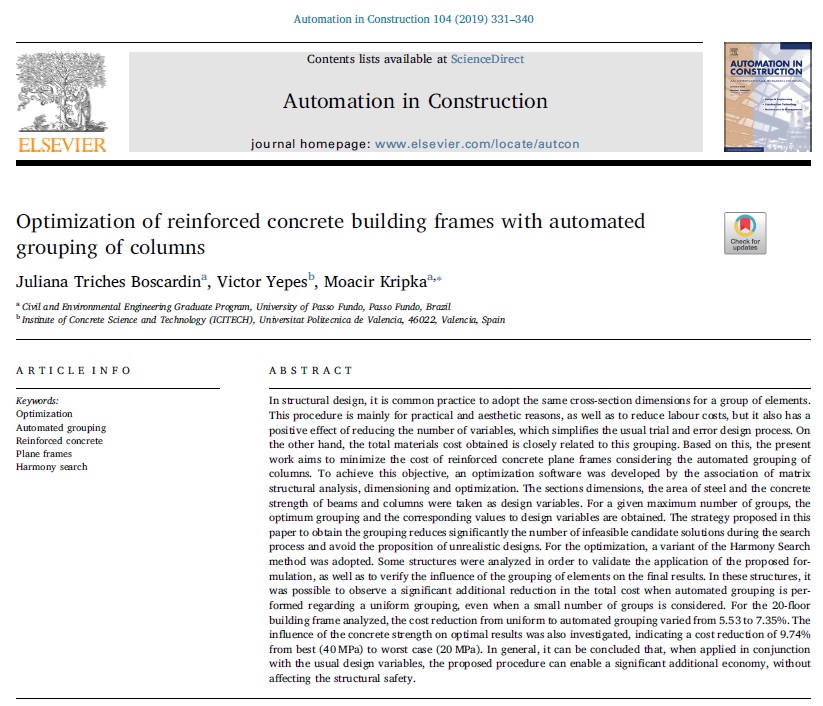 Nos acaban de publicar en la revista Automation in Construction (primer cuartil del JCR) un artículo relacionado con la optimización de pórticos de hormigón armado con sistemas de agrupación de columnas. Se trata de una colaboración con el profesor Moacir Kripka y está dentro del proyecto de investigación DIMALIFE.
Nos acaban de publicar en la revista Automation in Construction (primer cuartil del JCR) un artículo relacionado con la optimización de pórticos de hormigón armado con sistemas de agrupación de columnas. Se trata de una colaboración con el profesor Moacir Kripka y está dentro del proyecto de investigación DIMALIFE.
Puedes descargar gratuitamente el artículo hasta el 22 de junio de 2019 en el siguiente enlace: https://authors.elsevier.com/a/1Y~vl3IhXMfb77
ABSTRACT
In structural design, it is common practice to adopt the same cross-sectiondimensions for a group of elements. This procedure is mainly for practical and aesthetic reasons, as well as to reduce labour costs, but it also has a positive effect of reducing the number of variables, which simplifies the usual trial and error design process. On the other hand, the total materials cost obtained is closely related to this grouping. Based on this, the present work aims to minimize the cost of reinforced concrete plane frames considering the automated grouping of columns. To achieve this objective, an optimization software was developed by the association of matrix structural analysis, dimensioning and optimization. The sections dimensions, the area of steel and the concrete strength of beams and columns were taken as design variables. For a given maximum number of groups, the optimum grouping and the corresponding values to design variables are obtained. The strategy proposed in this paper to obtain the grouping reduces significantly the number of infeasible candidate solutions during the search process and avoid the proposition of unrealistic designs. For the optimization, a variant of the Harmony Search method was adopted. Some structures were analyzed in order to validate the application of the proposed formulation, as well as to verify the influence of the grouping of elements on the final results. In these structures, it was possible to observe a significant additional reduction in the total cost when automated grouping is performed regarding a uniform grouping, even when a small number of groups is considered. For the 20-floor building frame analyzed, the cost reduction from uniform to automated grouping varied from 5.53 to 7.35%. The influence of the concrete strength on optimal results was also investigated, indicating a cost reduction of 9.74% from best (40 MPa) to worst case (20 MPa). In general, it can be concluded that, when applied in conjunction with the usual design variables, the proposed procedure can enable a significant additional economy, without affecting the structural safety.
KEYWORDS
Optimization; automated grouping; reinforced concrete; plane frames; harmony search
Reference:
BOSCARDIN, J. T.; YEPES, V.; KRIPKA, M. (2019). Optimization of reinforced concrete building frames with automated grouping of columns. Automation in Construction, 104: 331-340. DOI:10.1016/j.autcon.2019.04.024
